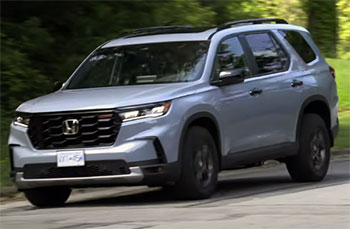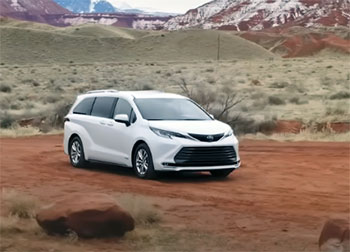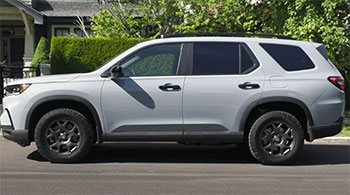As a parent juggling kids, pets, and endless errands, I’ve spent countless hours researching the perfect family vehicle. The 2025 Honda Pilot and Toyota Sienna caught my eye for their spacious interiors and family-friendly features, but they cater to different needs.
The Pilot, a rugged midsize SUV, promises versatility, while the Sienna, a hybrid minivan, emphasizes efficiency and convenience. In comparison, I’ll share my firsthand insights, weighing pros and cons to help you decide which fits your lifestyle. Below, a comparison table sets the stage, followed by detailed experiences and an FAQ to guide your choice.
| Feature | Honda Pilot (2025) | Toyota Sienna (2025) |
|---|---|---|
| Vehicle Type | Midsize SUV | Minivan (Hybrid) |
| Base Price | $40,595 | $39,185 |
| Engine | 3.5L V6, 285 hp | 2.5L 4-cylinder hybrid, 245 hp |
| Fuel Economy (MPG) | 19 city / 26 highway / 22 combined | 36 city / 36 highway / 36 combined (FWD) |
| Drivetrain | FWD or AWD | FWD or AWD |
| Seating Capacity | 7 or 8 | 7 or 8 |
| Cargo Space (cu ft) | 18.6 (behind 3rd row), 111.8 (max) | 33.5 (behind 3rd row), 101.0 (max) |
| Safety Rating (NHTSA) | 5 stars | 5 stars |
| Reliability (J.D. Power) | 77/100 | 76/100 |
| Key Features | Apple CarPlay, Android Auto, 8.0-inch touchscreen | Toyota Safety Sense P, 9.0-inch touchscreen, hybrid powertrain |
My Experience With the Honda Pilot

Driving the 2025 Honda Pilot felt like slipping into a reliable, do-it-all companion.
As a family of four with two kids and a dog, I needed a vehicle that could handle daily commutes, weekend adventures, and the occasional off-road trail.
The Pilot’s rugged SUV design and available all-wheel drive (AWD) gave me confidence on gravelly backroads during a camping trip in Colorado.
Its 3.5-liter V6 engine, pumping out 285 horsepower, offered smooth acceleration, making highway merges effortless.
The spacious interior, with up to eight seats, accommodated my family and gear, though the third row felt snug for adults.
The Pilot’s cabin struck me as practical yet unflashy. The 8.0-inch touchscreen was responsive, and standard Apple CarPlay and Android Auto made navigation a breeze.
I appreciated the massive center console for stashing snacks and toys, but the piano-black trim attracted fingerprints like a magnet.
On a road trip, the Pilot’s comfortable front seats and quiet ride kept everyone happy, though fuel economy—22 MPG combined—stung at the pump compared to hybrids. Safety features like adaptive cruise control and lane-keeping assist worked seamlessly, giving me peace of mind with kids in the back.
However, the Pilot isn’t perfect. Its higher ground clearance made it trickier for my toddler to climb in, and the lack of sliding doors meant wrestling with car seats in tight parking lots. While it’s marketed as adventure-ready, serious off-roading is a stretch—stick to light trails. Overall, the Pilot felt like a versatile jack-of-all-trades, ideal for families who want SUV styling with minivan-like practicality.
My Experience With the Toyota Sienna

The 2025 Toyota Sienna redefined my view of minivans. As a hybrid, it delivered an impressive 36 MPG combined, a game-changer for my budget-conscious side.
Driving it felt surprisingly car-like, with responsive steering and a smooth ride, even on long hauls.
The Sienna’s sliding doors were a revelation—loading kids and groceries in a crowded Costco parking lot was a breeze.
Its cavernous interior, with 33.5 cubic feet behind the third row, swallowed strollers and sports equipment without complaint, though max cargo space lagged behind the Pilot.
Inside, the Sienna’s 9.0-inch touchscreen and standard Toyota Safety Sense P suite (including pedestrian detection and adaptive cruise) impressed me.
The cabin felt upscale, with soft-touch surfaces and clever storage, though the infotainment system occasionally lagged.
My kids loved the optional rear entertainment system, but I wished the second-row seats folded flat or were removable for max cargo flexibility. The hybrid powertrain, with 245 horsepower, felt adequate but sluggish on steep hills, especially when towing a small trailer.
The Sienna’s AWD option handled snowy roads well during a winter drive, and its lower profile made it easier for my kids to hop in. However, the low ground clearance worried me on uneven terrain, and the hybrid battery’s placement under the front seats meant no spare tire in some trims. For families prioritizing efficiency and convenience, the Sienna shines, but it’s strictly a pavement cruiser.
Pros Of the Honda Pilot

- Powerful V6 Engine: The 3.5-liter V6 delivers 285 horsepower, making it quick to merge onto highways or pass slower traffic. It felt peppy during my test drives, even with a full load.
- Versatile AWD System: Available all-wheel drive with torque vectoring handled light off-road trails and snowy roads with ease, perfect for my weekend getaways.
- Spacious Cargo Capacity: With 111.8 cubic feet of max cargo space, the Pilot swallowed camping gear, bikes, and luggage, outpacing the Sienna’s max capacity.
- Comfortable Front Seats: The front seats were plush and supportive, ideal for long drives, with optional heating and ventilation adding luxury.
- Solid Safety Ratings: A 5-star NHTSA rating and features like blind-spot monitoring gave me confidence hauling my family.
- Flexible Seating Options: Offering 7 or 8 seats, the Pilot adapts to different family sizes, with captain’s chairs in higher trims adding comfort.
- Rugged Styling: The Pilot’s bold, SUV look appealed to my preference for a tougher aesthetic over a minivan’s boxy profile.
The Honda Pilot’s strengths lie in its versatility and power. During a family road trip, the V6 engine made overtaking on highways stress-free, and the AWD system gripped well on a muddy trail to a campsite. The massive cargo area was a lifesaver when packing for a week-long vacation, fitting everything from coolers to folding chairs. I loved the straightforward infotainment system, which synced effortlessly with my phone. The Pilot’s higher ground clearance gave it an edge for occasional adventures, and its safety suite never felt intrusive. For families wanting an SUV that feels sporty yet practical, the Pilot delivers.
Read More: My Thoughts On Acura MDX Vs. Volvo XC90
Cons Of the Honda Pilot
- Mediocre Fuel Economy: At 22 MPG combined, the Pilot guzzled gas compared to the Sienna, costing me about $2,500 annually at $3.50 per gallon for 15,000 miles.
- Tight Third Row: The third row cramped adults during long drives, better suited for kids or short trips.
- No Sliding Doors: Fixed doors made accessing the rear seats tricky in tight spaces, a hassle with car seats and kids.
- Expensive Higher Trims: The base LX starts at $40,595, but fully loaded trims like the Black Edition push past $50,000, stretching my budget.
- Limited Off-Road Capability: Despite its rugged look, the Pilot struggled on anything beyond light trails, disappointing my off-road aspirations.
- Fingerprint-Prone Interior: The piano-black trim looked sleek but showed every smudge, requiring constant cleaning with kids around.
- Average Reliability: J.D. Power’s 77/100 score is decent, but I worried about long-term repair costs compared to Toyota’s reputation.
The Pilot’s fuel economy was a constant pain point, especially on long trips where I watched the gas gauge drop faster than expected. The third row’s tight space frustrated my taller relatives, and the lack of sliding doors turned parking lot maneuvers into a workout. Higher trims felt like a splurge, and the interior’s smudge-prone surfaces annoyed me daily. While the AWD system was solid, I wouldn’t trust the Pilot for serious off-roading—it’s more suburban than wilderness warrior. For families on a tighter budget or needing max efficiency, these drawbacks might steer you elsewhere.
Pros Of the Toyota Sienna
- Outstanding Fuel Economy: The hybrid powertrain’s 36 MPG combined saved me roughly $1,000 annually compared to the Pilot, a huge win for my wallet.
- Sliding Doors: Automatic sliding doors made loading kids and gear in tight spaces effortless, a game-changer for busy parents like me.
- Standard Safety Suite: Toyota Safety Sense P, with pedestrian detection and lane departure assist, came standard, boosting my confidence on the road.
- Spacious Interior: With 33.5 cubic feet behind the third row, the Sienna easily fit strollers and groceries, perfect for daily errands.
- AWD Option: Available all-wheel drive handled winter roads well, making it a practical choice for snowy climates.
- Comfortable Ride: The Sienna’s car-like handling and smooth suspension kept my family comfortable, even on bumpy roads.
- High Resale Value: Retaining 59.4% of its value after five years, the Sienna held its worth better than the Pilot’s 56.4%.
The Sienna’s hybrid efficiency was a standout, cutting my fuel costs significantly during a 500-mile road trip. The sliding doors were a lifesaver in crowded parking lots, letting my kids hop in without dinging nearby cars. The safety features worked flawlessly, and the interior’s storage nooks kept toys and snacks organized. I appreciated the AWD option in snowy weather, and the smooth ride made long drives pleasant. The Sienna’s strong resale value gave me confidence in its long-term value, making it a smart choice for families prioritizing efficiency and convenience.
Cons Of the Toyota Sienna
- Sluggish Acceleration: The 245-horsepower hybrid felt underpowered, especially when towing or climbing steep hills, leaving me wanting more grunt.
- Non-Removable Second Row: The second-row seats don’t fold flat or remove, limiting cargo versatility compared to the Pilot.
- Low Ground Clearance: At 6.3 inches, the Sienna scraped on uneven terrain, making it less ideal for camping or rural drives.
- Fickle Infotainment: The 9.0-inch touchscreen lagged at times, frustrating me when navigating or pairing devices.
- No Spare Tire (Some Trims): The hybrid battery’s placement eliminated the spare tire in some models, a concern for long trips.
- Higher Repair Severity: J.D. Power notes that while repair frequency is average, issues can be more severe, potentially hiking costs.
- Minivan Stigma: Despite its sleek design, the Sienna’s minivan label felt less “cool” than the Pilot’s SUV vibe for my image-conscious side.
The Sienna’s sluggish acceleration was noticeable when merging onto highways, especially with a full load. The fixed second-row seats frustrated me when I needed to haul large items, forcing me to get creative with cargo. Low ground clearance made me cautious on dirt roads, and the infotainment glitches disrupted my playlists. The lack of a spare tire in some trims worried me on remote drives, and the potential for costly repairs lingered in my mind. For families needing max power or off-road capability, the Sienna’s limitations might be dealbreakers.
Read More: My Thoughts On BMW X7 Vs. Cadillac Escalade
Frequently Asked Questions (FAQ)
The Honda Pilot has mediocre fuel economy (22 MPG combined), a cramped third row for adults, no sliding doors, expensive higher trims, limited off-road capability, fingerprint-prone interior, and average reliability (J.D. Power 77/100).
The Toyota Sienna suffers from sluggish acceleration, non-removable second-row seats, low ground clearance, inconsistent infotainment, no spare tire in some trims, potentially severe repairs, and the minivan stigma.
Both the Toyota Sienna and Honda Odyssey have 5-star NHTSA safety ratings. The Sienna edges out slightly with standard Toyota Safety Sense P across all trims, while Odyssey’s advanced safety features are limited to higher trims.
The Honda Odyssey is the direct equivalent to the Toyota Sienna, as both are minivans designed for family practicality. The Honda Pilot, while spacious, is an SUV with different dynamics.
Conclusion: For Honda Pilot and Toyota Sienna
Choosing between the 2025 Honda Pilot and Toyota Sienna depends on your priorities. If you crave SUV styling, power, and light off-road capability, the Pilot’s robust V6 and massive cargo space make it a solid pick, despite its thirst for gas and tight third row. If fuel efficiency and family-friendly features like sliding doors are your focus, the Sienna’s hybrid economy and spacious interior shine, though its sluggish acceleration and fixed seats may frustrate. Test-drive both to feel which suits your lifestyle—your family’s needs will steer you to the right choice.

